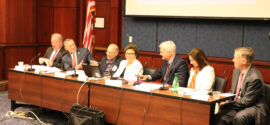Dyslexia Workarounds: Creativity Without a Lot of Reading
By Melinda Beck, The Wall Street Journal, Health Journal
April 1, 2013
Citing successful dyslexics like Connecticut Governor Dannel Malloy, Cleveland Clinic CEO and thoracic surgeon Dr. Toby Cosgrove, and actor and children’s book author Henry Winkler, WSJ journalist Melinda Beck brings the positive side of dyslexia to light—and also the necessary accommodations for overcoming dyslexia. “I frankly think that dyslexia is a gift,” Dr. Cosgrove tells Beck. “If you are supported in school and your ego remains intact, then you emerge with a strong work ethic and a different view of the world.”
Beck consulted YCDC Co-Director Dr. Sally E. Shaywitz for the article, who offered her scientific knowledge on the subject of dyslexia, as well as her insights into what dyslexics encounter while reading and working through their disability.
An excerpt from the article:
As many as one in five Americans has some degree of dyslexia, according to Yale research, although only about 5% of children have been formally diagnosed…. Imaging studies show that the best readers have the most brain activity in the rear, instant-word-forming area when they read. Dyslexics have much less activity there and more in two slower areas. “Think of the word ‘bat,'” says Dr. Shaywitz. “If you are dyslexic, you have to retrieve the B and the A and the T separately each time. It’s exhausting.”
Read the article in its entirety on The Wall Street Journal website. Click here.
Related

Congressional Dyslexia Roundtable
Excited, we have unusually positive news to share about science, dyslexia and legislation. Far too often there is …
Read MoreUpdate on the Connecticut Longitudinal Study (CLS)
Much of this new scientific understanding of dyslexia has emerged from a longitudinal study, the Connecticut Longitudinal Study …
Read MoreCoursera: Exciting New Online Dyslexia Course
A very exciting announcement that positively impacts children with dyslexia, their parents and their teachers is the Dyslexia …
Read MoreWho will be the first civilian in space? A dyslexic of course—Sir Richard Branson.
Who will be the first civilian in space? A dyslexic of course—Sir Richard Branson. On Sunday, Sir Richard …
Read More